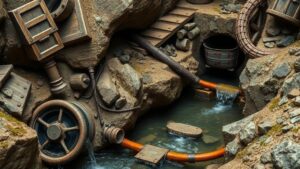Recognizing the Importance of Ore Cracking Techniques in Antiquity
Recognizing the Importance of Ore Cracking Techniques in Antiquity
Ore cracking techniques played a pivotal role in the advancement of metallurgy during antiquity. These early methods were essential not only for the extraction of precious metals but also for the development of tools and weapons that shaped civilizations. Understanding these techniques offers valuable insights into the technological and social progress of ancient societies.
The Historical Context of Ore Cracking
The timeline of ore cracking can be traced back to the Bronze Age, around 3000 BCE, when humans learned to exploit mineral resources more effectively. Early civilizations, including the Egyptians, Sumerians, and Greeks, utilized simple yet effective techniques to extract metals from ores. The techniques employed were largely dictated by available technology and the specific characteristics of the ores being processed.
Ore Cracking Techniques
Ore cracking primarily involves breaking down ores to liberate the desired metal. Key techniques included:
- Hand Tools: Early miners used hammers and chisels made from stone or wood to break apart ore.
- Fire Setting: This method involved heating the ore with fire and then cooling it rapidly, which caused it to crack.
- Water Power: In some cultures, water wheels were utilized to drive hammers that pulverized ore.
Case Studies in Ore Cracking Techniques
Examining case studies from different ancient civilizations highlights the variations and adaptations of ore cracking methods:
The Egyptian Approach
The ancient Egyptians demonstrated a sophisticated understanding of ore extraction. primarily mined gold in the Eastern Desert, utilizing methods that included fire setting to crack the ore and subsequent panning to separate gold from waste. Archaeological evidence suggests that these techniques enabled them to produce substantial quantities of gold, which played a significant role in their economy and culture.
The Roman Innovations
The Romans expanded upon earlier mining techniques by introducing tools such as the dolly or hand-operated winch that could lift heavy ore. Also, they developed more complex smelting techniques, including the use of bellows to increase the temperature during metal processing, which improved yield rates significantly.
Technological Evolution and Its Impact
The evolution of ore cracking techniques over time reflects a broader trend of technological advancement in metallurgy. As societies grew more complex, so did their mining techniques. The shift from primitive to more sophisticated methods of ore extraction not only fulfilled the rising demand for metals but also enabled significant developments in farming, warfare, and construction.
Challenges in Ore Cracking
Despite the advancements, ancient cultures faced numerous challenges in ore cracking. These included:
- Resource Limitation: Not all regions possessed accessible, rich ore deposits.
- Environmental Impact: Early mining practices could lead to soil degradation and deforestation.
- Safety Hazards: Miners often faced dangerous conditions, including collapses and exposure to toxic substances.
Conclusion: The Legacy of Ore Cracking Techniques
The techniques used in ore cracking during antiquity laid the groundwork for modern metallurgy. Understanding these historical methods not only sheds light on how ancient civilizations prospered but also emphasizes the innovation and adaptability of human beings in overcoming natural challenges. The study of these techniques remains relevant today, reminding us of the intricate relationship between technology and society throughout history.
Actionable Takeaways
- Recognize the historical significance of mining techniques in shaping civilizations.
- Explore the innovations in metallurgy that have roots in ancient practices.
- Consider the environmental and safety implications of mining, echoing lessons from the past for sustainable practices today.



